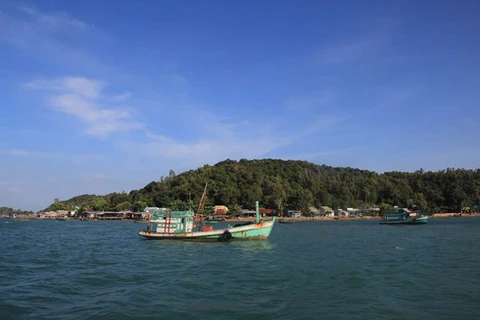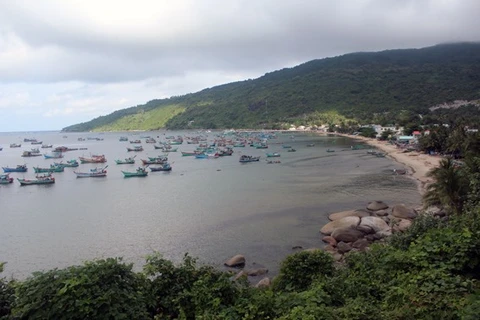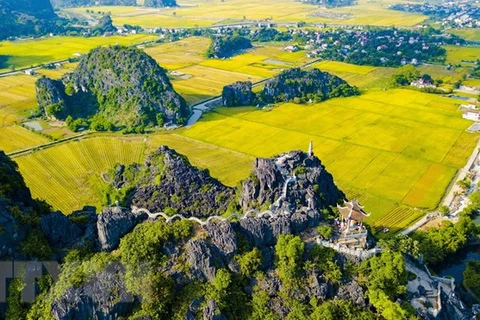
Hanoi (VNA) - Many destinations across Vietnam have not only scenic beauty but also unusual names, which come from interesting stories that not many people know about. Some of them are Hang Mua (Cave of Dance), Hon Rai (Otter island), Hai Tac (Pirate) island, or Doi Thong Hai Mo (Two-tomb pine hill).
Hang Mua (Hoa Lu district, northern province of Ninh Binh)
Emerging as one of the “hottest” destinations in the northern region in the past year, Hang Mua is also dubbed the Vietnamese version of the Great Wall of China. The name of the mountain triggers curiosity as few know about its origin.
Legend has it that during the Tran Dynasty, the Tran kings established the Thai Vy Temple in Hoa Lu and regularly came there to watch their concubines sing and dance, which is why locals called the area Hang Mua.
The Hang Mua is located on Mua mountain, which is the highest in Ninh Binh. You have to climb nearly 500 steps to reach the top of the mountain, from where you can see the impressive beauty of Tam Coc, which is the most beautiful in the ripe rice season.
 You have to climb nearly 500 steps to reach the top of the mountain, from where you can see the impressive beauty of Tam Coc, which is the most beautiful in the ripe rice season.
You have to climb nearly 500 steps to reach the top of the mountain, from where you can see the impressive beauty of Tam Coc, which is the most beautiful in the ripe rice season.(Photo: VietnamPlus)
Hon Rai (Kien Hai district, the southern coastal province of Kien Giang)
Hon Rai is thought to take its name from the otters which used to live here in large numbers in the past.
It also has another name, Hon Son, as locals said long ago there were many “dau rai” trees on the island, the resin of which was used to cover boats to prevent water from leaking in.
The island, located between Nam Du and Hon Tre islands, is said to be one of the most beautiful wild islands in Vietnam.
Dao Hai Tac (Ha Tien district, Kien Giang province)
Hai Tac is in fact a group of 16 islands, with the biggest being Hon Tre (also called Hon Doc) which is 40km from Phu Quoc island. It was discovered in the late 17th century, and used to be the base of the infamous Canh buom den (Black sail) band of pirates with many eerie and mysterious folk stories. That is possibly why locals named it Hai Tac.
 Hai Tac is in fact a group of 16 islands, with the biggest being Hon Tre (also called Hon Doc) which is 40km from Phu Quoc island. (Photo: VietnamPlus)
Hai Tac is in fact a group of 16 islands, with the biggest being Hon Tre (also called Hon Doc) which is 40km from Phu Quoc island. (Photo: VietnamPlus) To reach Hai Tac, visitors can take the high-speed boat Greenlines A1 from Hon Tien town, which takes 30 minutes, or use the normal ferries such as Huong Xua, Minh Nga and Bao Thien, which takes longer, 75 minutes. While cruising, visitors can see fish raising rafts of local farmers at sea.
Doi Thong Hai Mo (the resort city of Da Lat, the Central Highlands province of Lam Dong)
Located in the romantic Da Lat city, the pine hill is associated with a sad love story which was well-known in the south Vietnam before the liberation in 1975. At the foot of the hill, there was a pair of tombs, said to be of a young man named Vu Minh Tam and a young woman named Le Thi Thao.
The two were much in love with each other but could not get married. They chose to kill themselves so that they would be able to be with each other forever.
The couple was buried at the foot of the pine hill. Since then, the lake near the hill had its name changed from Suong Mai (Morning dew) to Than Tho (Lake of Sighs), in remembering the sad love story of the unfortunate couple.
Ghenh Da Dia (Cliff of Stone Plates) (Tuy An district, the south central province of Phu Yen)
Known as a unique natural scenic spot with outstanding geological value in Vietnam’s coastal region, the seashore area is home to uniformly interlocking basalt rock columns located along the coast.
The cliffs are dark lava hexagonal columns with flat surfaces, resembling dinner plates, hence the name – Ghenh Da Dia.
 The cliffs are dark lava hexagonal columns with flat surfaces, resembling dinner plates, hence the name – Ghenh Da Dia.(Photo: VNA)
The cliffs are dark lava hexagonal columns with flat surfaces, resembling dinner plates, hence the name – Ghenh Da Dia.(Photo: VNA) The basalt cliffs are the result of ancient volcanic eruptions. When the molten basalt flows met the cool water they hardened and formed these rare polygonal columns.
Ghenh Da Dia is about 50m wide and stretches over 2,000m long. Each column has an average visible height of 60-80cm, cross-section of 20-30cm. There are an estimated 35,000 rock columns standing in close position as if supernaturally placed.
The site is about 40km from Tuy Hoa city.To reach it from Tuy Hoa, you can drive north about 30km. When reaching Chi Thanh town, you should turn right and go a further 15km.
If you want to enjoy the beautiful sea, the 35-km long coastal road along Tuy Hoa would be a good choice./.

























